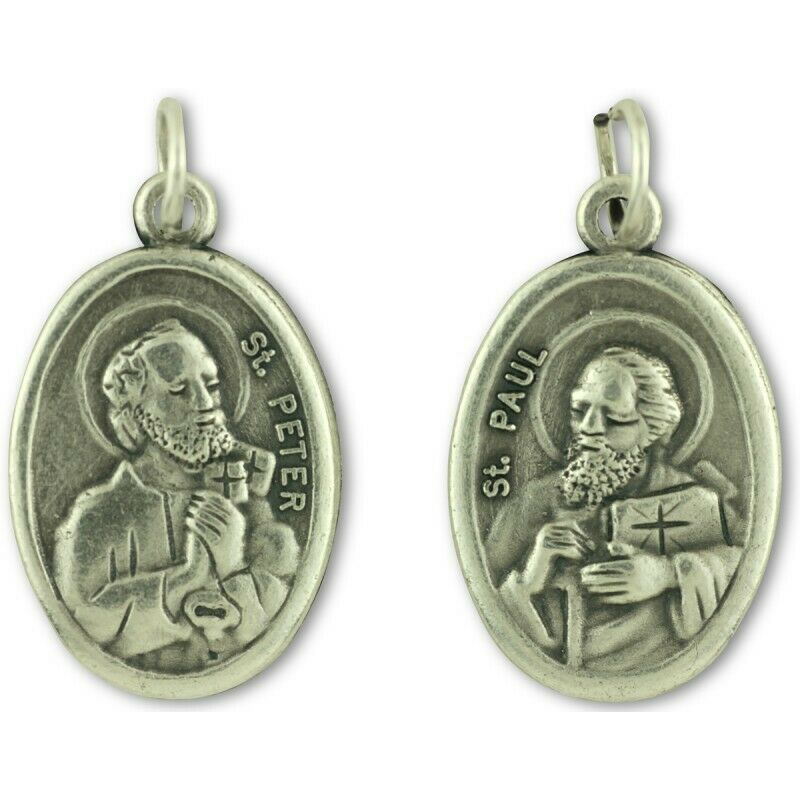-40%
Holy Card of Saints Peter and Paul & the Risen Christ Plus a 1" Medal
$ 2.5
- Description
- Size Guide
Description
Laminated Holy Card of Saints Peter and Paul and the Risen Christ Plus a 1" Silver Oxidized Medal of Saints Peter and Paul.Condition is "New". Shipped with USPS First Class.
This exceptionally detailed die-cast medal, with an image of St. Peter on one side and St. Paul on the other side, is made in the region of Italy that produces the finest quality medals in the world. The silver oxidized finish is has been perfected for hundreds of years by the local Italian craftsmen, and remains unmatched in quality, beauty, and longevity -a genuine silver plating with a 3-dimensional depth, and long-lasting brilliance. Attached jump ring is included.
Saint Peter wasone of the Twelve Apostles of Jesus Christ, and one of the first leaders of theearly Church.
According toChristian tradition, Peter was crucified in Rome under Emperor Nero. He istraditionally counted as the first bishop of Rome—or pope—and also byEastern Christian tradition as the first patriarch of Antioch. The ancientChristian churches all venerate Peter as a major saint and as the founder ofthe Church of Antioch and the Diocese of Rome, but differ in their attitudesregarding the authority of his successors. According to Catholic teaching, inMatthew 16 (Matthew 16:18) Jesus promised Peter a special position in theChurch.
In the NewTestament, Peter appears repeatedly and prominently in all four gospels as wellas the Acts of the Apostles. The Gospel of Mark in particular was traditionallythought to show the influence of Peter's preaching and eyewitness memories. Heis also mentioned, under either the name Peter or Cephas, in Paul's FirstLetter to the Corinthians and the Epistle to the Galatians. The New Testamentalso includes two general epistles, First Peter and Second Peter that aretraditionally attributed to him, but modern scholarship generally rejects thePetrine authorship of both.
Paul theApostle, commonly known as Saint Paul and also known by his Hebrew name Saul ofTarsus, was a Christian apostle (although not one of the Twelve Apostles) whospread the teachings of Jesus in the first-century world. Generally regarded asone of the most important figures of the Apostolic Age, he founded severalChristian communities in Asia Minor and Europe from the mid-30s to the mid-50sAD.
According tothe New Testament book Acts of the Apostles (often simply called Acts), Paulparticipated in the persecution of early disciples of Jesus, possiblyHellenised diaspora Jews converted to Christianity, in the area of Jerusalem, priorto his conversion. In the narrative of Acts, Paul was traveling on the roadfrom Jerusalem to Damascus on a mission to "arrest them and bring themback to Jerusalem" when the ascended Jesus appeared to him in a greatbright light. He was struck blind, but after three days his sight was restoredby Ananias of Damascus and Paul began to preach that Jesus of Nazareth is theJewish messiah and the Son of God.[Acts 9:20–21] Approximately half of the bookof Acts deals with Paul's life and works.
Fourteen ofthe twenty-seven books in the New Testament have traditionally been attributedto Paul. Seven of the Pauline epistles are undisputed by scholars as beingauthentic, with varying degrees of argument about the remainder. Paulineauthorship of the Epistle to the Hebrews is not asserted in the Epistle itselfand was already doubted in the 2nd and 3rd centuries. It was almostunquestioningly accepted from the 5th to the 16th centuries that Paul was theauthor of Hebrews, but that view is now almost universally rejected byscholars. The other six are believed by some scholars to have come fromfollowers writing in his name, using material from Paul's surviving letters andletters written by him that no longer survive[note. Other scholars argue thatthe idea of a pseudonymous author for the disputed epistles raises many problems.
Today,Paul's epistles continue to be vital roots of the theology, worship andpastoral life in the Latin and Protestant traditions of the West, as well asthe Eastern Catholic and Orthodox traditions of the East. Paul's influence onChristian thought and practice has been characterized as being as"profound as it is pervasive", among that of many other apostles andmissionaries involved in the spread of the Christian faith.











